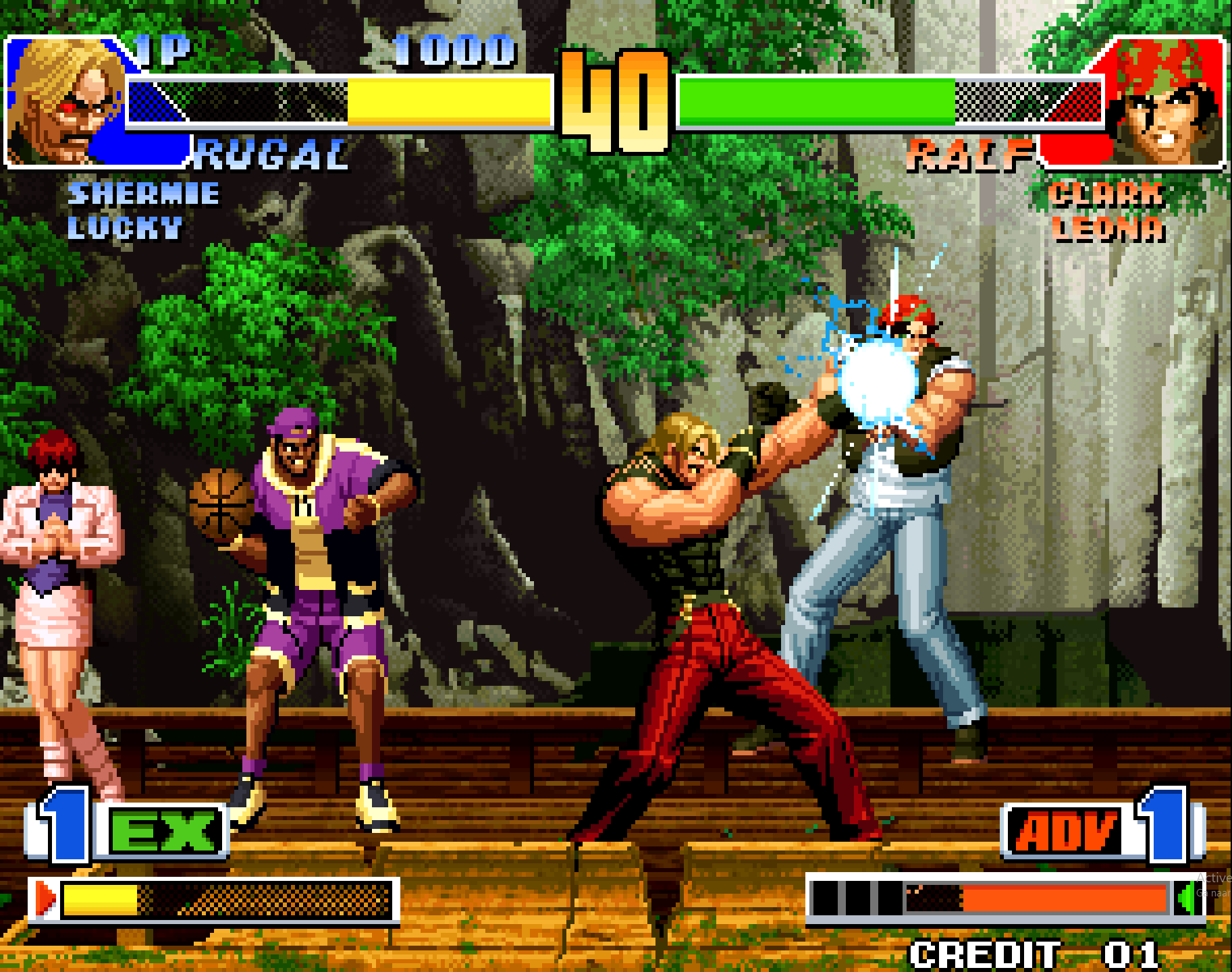Introduction: The Unsung King
In the pantheon of fighting games, three titans stand tall: Street Fighter, Mortal Kombat, and The King of Fighters. But while the first two earned global recognition through splashy violence and early console ports, KOF became a cult juggernaut in arcades and beyond, celebrated by connoisseurs for its deep mechanics, mythic storytelling, and legendary pixel artistry.
What began in 1994 as an ambitious crossover quickly evolved into a living, evolving world with serialized arcs, character rivalries spanning generations, and a global competitive scene stretching from Mexico City to Hong Kong. Unlike its louder counterparts, KOF didn’t beg for attention — it earned loyalty through consistency, technical brilliance, and its roots in SNK's unique game development philosophy.
This is the story of the world’s most quietly revolutionary fighting game franchise, told through the voices of those who made it.

From a Beat-‘Em-Up to a Revolution: KOF ‘94’s Origins
Before it was a fighting game, The King of Fighters was a failed beat-‘em-up. Originally titled Survivor, the game was conceived as a side-scrolling action title involving rival gangs battling across a city — inspired by Final Fight and SNK’s own Burning Fight. But as fighting games exploded in the early 1990s, the Survivor team made a bold pivot.
“We wanted to stand out from Street Fighter. We didn’t want just another 1v1.” – Toyohisa Tanabe (Planner & Director, KOF '94–'98)
Tanabe proposed a 3-on-3 team-based format, allowing players to pick squads instead of a single fighter. That idea — born of both gameplay experimentation and asset reuse — would define the franchise.
“To have an edge over other fighting games, we kept the concept of fighting in 3-vs-3 teams.” – Tanabe
Characters from Fatal Fury, Art of Fighting, Ikari Warriors, and Psycho Soldier were pulled together into a single universe. But rather than feel like a gimmick, this crossover was used to build a new world. Nationally themed teams like Team Japan, Team USA, and Team Korea gave the roster identity, while new characters like Kyo Kusanagi and Rugal Bernstein were created to anchor the emerging mythology.
SNK had no idea how successful the gamble would be.
“We didn’t know if people would get it. We just put our hearts into it.” – Shinichi Shimizu (Programmer, KOF '94–'96)
KOF '94 debuted to packed arcades and long queues. Within weeks, the internal mood at SNK had shifted. The team was no longer just patching a fighting engine together — they were building a universe.

The Orochi Saga: Arcade Storytelling Ascends
While other fighting franchises barely connected their sequels, KOF dared to tell a serialized, year-over-year story. From KOF ‘95 to KOF ‘97, SNK developed the Orochi Saga, a mythologically inspired narrative following Kyo, his rival Iori Yagami, and a cursed bloodline rooted in Japanese legend.
“Since both Kusanagi and Yagami were based on myths, I decided to give Orochi a mysterious image.” – Toyohisa Tanabe
KOF ‘95 added team edit and rival characters, but KOF ‘96 truly ramped up production values and introduced fan-favorite Iori. KOF ‘97, the climax, was SNK’s most polished narrative yet. Players could feel it in the pacing, backgrounds, and cinematic finish.
“Tanabe finished the Orochi Saga in one of the most epic ways possible.” – Eisuke Ogura (Lead Artist, KOF 2001–XV)
Fan polls and magazine surveys were used to help guide roster choices and gameplay tweaks. KOF was no longer just a product — it was a live conversation between SNK and its players.

Pixels and Purpose: The Art of SNK
KOF’s visual style became its soul. Shinkiro’s early promo art gave the series a painted realism, but the in-game pixel work was just as impressive. Animators like Hiroaki and later Ogura built each fighter with hundreds of frames, flowing movements, and trademark flourishes.
“We had color limits and RAM constraints. But we pushed the Neo Geo to its edge.” – Shinichi Shimizu
From Iori’s flaming super to Blue Mary’s grapples, KOF’s sprites were dense, expressive, and complex. No other fighter of the era — not even Street Fighter Alpha — looked quite like it.
With KOF XII and XIII, SNK attempted a bold return to hand-drawn 2D with HD sprites. The result? Some of the most breathtaking pixel art in fighting game history, even if the games’ balance suffered.
“We wanted to honor the past but push forward. Every pixel had to be intentional.” – Masaaki Kukino (Director, KOF XII–XIII)

From Osaka to Oaxaca: KOF’s Global Footprint
KOF found loyal audiences in surprising places. While Street Fighter dominated in Japan and the U.S., KOF became a religion in Mexico, China, Brazil, and the Philippines.
“In Mexico, we had arcades running KOF for over 20 years straight.” – Wired Magazine, 2009
Unlike Capcom, SNK localized aggressively and kept prices relatively low. KOF cabinets were accessible and durable. The 3v3 format mirrored local community culture, where play was often shared and characters were discussed like sports teams.
In Hong Kong, KOF was considered more technical than Capcom’s offerings. In Brazil, it was the tournament game of choice into the 2000s. In China, KOF became the default arcade fighter, spawning imitators and endless bootlegs.

Sound & Style: The Mood of KOF
KOF's music evolved just as dramatically. Composer Hideki Asanaka led SNK’s sound team, creating themes that ranged from jazzy and laid-back to apocalyptic and mythic.
“We had four months to do the music. But we knew what KOF had to sound like.” – Hideki Asanaka (Lead Composer, KOF '95–XV)
Whether it was the saxophone-driven “Arashi no Saxophone” or the solemn Esaka theme, each team had a musical identity. Later entries experimented with rock, electronica, and orchestral cues.
The use of the Yamaha YM2610 FM chip pushed the Neo Geo’s audio hardware to its limit, creating rich, multi-layered tracks despite limitations.

Soundtrack: The King of Fighters '97 - Rhythmic Hallucination
Mastery and Mechanics: The Thinking Fighter
KOF isn’t just stylish. It’s also one of the most mechanically demanding fighting games ever made. Every match requires managing three characters, knowing matchups, conserving meter, and maintaining momentum.
KOF '98 and 2002 UM are still played competitively today due to their near-perfect balance and combo freedom. KOF XIII introduced Hyperdrive Cancels — allowing for explosive expression, but only in the hands of technical players.
“If Street Fighter is checkers, KOF is chess with a timer.” – EventHubs review, 2021
Rollback netcode in KOF XV finally brought SNK’s gameplay online without delay-based frustration. The franchise had evolved — but it hadn’t lost its soul.

From Ashes to Orochi: KOF’s Modern Era
After SNK’s bankruptcy in 2001, many assumed KOF was finished. But the devs refused to let it die. With Atomiswave hardware and a passionate core team, SNK Playmore rebooted the saga with new arcs: NESTS, then Ash Crimson’s controversial storyline.
Eventually, the company stabilized. Under producer Yasuyuki Oda, KOF XIV brought the franchise into full 3D, while KOF XV refined the look and added rollback netcode, luring the global FGC back.
“We knew following up on XIII and 98 was going to be hard. But we had to evolve.” – Yasuyuki Oda (Producer, KOF XIV–XV)
Fan favorites returned. Chizuru rejoined Kyo and Iori. The Orochi Saga resumed. KOF XV wasn’t perfect, but it was proof that the series was alive — and still willing to surprise.
Legacy: 30 Years, 3 Characters at a Time
What makes KOF different isn’t just its mechanics. It’s the soul behind the sprites, the passion of its creators, and the devotion of its global fans. It’s a series that grew up with its audience — and stayed with them.
From the smoky arcades of Osaka to underground tournaments in Guadalajara, The King of Fighters earned its crown the hard way: through technical elegance, global reach, and a team that never stopped caring.
“I hope they keep making KOF games up to 2094.” – Toyohisa Tanabe
If they do, it’ll be because of the fire they lit back in 1994 — a flame that still burns.

Sources & Further Reading
- The King of Fighters: The Ultimate History (Bitmap Books, 2022): Includes interviews with Toyohisa Tanabe, Shinichi Shimizu, Eisuke Ogura, Hideki Asanaka, Masaaki Kukino.
- Arcade Mania! by Brian Ashcraft (2008)
- Wired Magazine (2009). "Street Fighter: Where It All Began."
- EventHubs.com — Competitive breakdowns and player commentary, 2021–2024.
- DreamCancel interview with Yasuyuki Oda (2018).
Want to Go Deeper Into Arcade History?
- What Makes an Arcade Game Great? – A deep dive into the design principles behind the most unforgettable cabinets of all time
- Inside the Metal Slug Legacy: The Developers Who Made It a Classic – How a small team at Nazca crafted one of the most iconic run-and-gun series of all time..
- The Complete History of Mortal Kombat Arcade – How a gritty fighter became a pop culture phenomenon.
- Capcom’s 19XX Series: The Complete History – The vertical shooters that defined a generation of arcade firepower.
- The History of Beat ’Em Up Arcade Games – From Double Dragon to Final Fight, here’s how brawlers ruled the late ’80s.
- The Complete History of Space Shooter Arcade Games – The genre that launched arcades into orbit.

